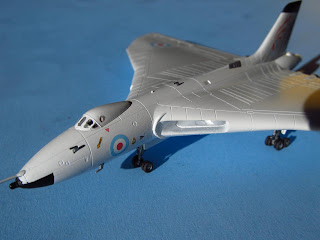Avro delivered 136 Vulcan bombers to the UK's Royal Air Force for deployment between 1956 and 1984. This was part of the UK V- Force, or the Bomber Command Main Force. Since the RAF could arrive at targets in the USSR several hours before the first wave of US strategic bombers, a secret UK/USA (SAC/RAF) agreement assigned the V-Force 106 urgent priority targets, including 69 cities, 17 strategic air bases, and 20 air defence missile sites. The RAF did not have the necessary number of nuclear weapons, but that was the plan.
The Vulcan B.2 bombers carried the Blue Steel stand-off missile. Avro made 53 operational missiles for the RAF, plus many training and flight testing versions. These were deployed between February 1963 and 31 December 1970, and were armed with the megatonne-class Red Snow thermonuclear warhead. The Red Snow warhead was an Anglicized copy of the US W-28 thermonuclear warhead greatly different from the original. The Blue Steel was the primary strategic nuclear weapons system in the UK arsenal until the introduction of the Polaris SLBM system. One big problem with Blue Steel was that it required up to seven hours of launch preparation, and was highly unreliable.
With a maximum range of only 240 km, most Blue Steel missiles would still have to be launched from inside the USSR. With the introduction of the MiG-21 interceptor, the high-level penetration tactic of the V-Force was considered obsolete, and the V-Force was shifted to low-altitude penetration with launch of the Blue Steel at only 300 m.
The RAF estimated a full half would fail to launch and would have to be dropped right on top of the target by the Vulcan, thus negating the whole purpose and value of a stand-off missile, while also assuring destruction of the bomber in a low-altitude mission.
From 1963, three squadrons of Vulcan B.2 were armed with the Blue Steel. The aircraft pictured (XL321) was operated by 617 (Dambuster) Sqdn at RAF Station Scampton in Lincolnshire, and is shown in the anti-flash gloss white colour scheme circa 1965. Both the aircraft and the missile sport the subdued markings and roundels, also meant to reduce heating of the surfaces in the event of a nearby nuclear flash. XL321 was built in 1962 and scrapped in 1987.
RAF Scampton hosted all three Blue Steel squadrons (27, 83, and 617) until the formal termination of strategic quick reaction alert (QRA) duty on 30 June 1968. Several new buildings were added to Scampton to support Blue Steel nuclear operations, including warhead storage and maintenance; and missile storage and missile fueling.
This kit was bought at the IPMS Ottawa kit swap meet and completed in five days. The white is Tamiya true white spray can paint. The signs on the tarmac read NO LONE ZONE, meaning there are nuclear weapons present and all operations must have at least two qualified personnel present.
UPDATE: This model placed third in the giant CAPCON biennial model contest on 28 September 2019 at the Canadian War Museum in Ottawa. (Microscale military aircraft - smaller than 1:72)
 |
| Vulcan B.2 with Blue Steel nuclear missile |
 |
| Actual Avro Vulcan B.2 with dummy W100A Blue Steel training shape in 1963 |
 |
| Vulcan B.2 with Blue Steel nuclear missile |
 |
| Vulcan B.2 with Blue Steel nuclear missile |
 |
| Vulcan B.2 with Blue Steel nuclear missile |
 |
| Vulcan B.2 with Blue Steel nuclear missile |
 |
| Vulcan B.2 with Blue Steel nuclear missile |
 |
| Vulcan B.2 with Blue Steel nuclear missile |
 |
| Vulcan B.2 with Blue Steel nuclear missile |
 |
| Vulcan B.2 with Blue Steel nuclear missile |
 |
| Vulcan B.2 with Blue Steel nuclear missile |
 |
| Vulcan B.2 with Blue Steel nuclear missile |
 |
| Vulcan B.2 with Blue Steel nuclear missile |
 |
| Vulcan B.2 with Blue Steel nuclear missile |
 |
| Vulcan B.2 with Blue Steel nuclear missile |
 |
| Actual Blue Steel missile on dolly beneath the Vulcan bomber at RAF Station Scampton |
 |
| Vulcan B.2 with Blue Steel nuclear missile |
 |
| Vulcan B.2 with Blue Steel nuclear missile |
 |
| Vulcan B.2 with Blue Steel nuclear missile |
 |
| Vulcan B.2 with Blue Steel nuclear missile |

